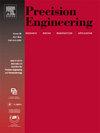光学表面自适应抛光中边缘控制和形状校正的混合物理和数据驱动建模
IF 3.5
2区 工程技术
Q2 ENGINEERING, MANUFACTURING
Precision Engineering-Journal of the International Societies for Precision Engineering and Nanotechnology
Pub Date : 2025-03-18
DOI:10.1016/j.precisioneng.2025.03.017
引用次数: 0
摘要
表面自适应抛光(SAP)工艺是一种很有前途的光学自由曲面超精密抛光方法。但该方法的损伤控制机理和形态控制理论有待进一步研究。为了确定抛光参数对表面和亚表面状态的影响机理,进行了一系列的实验研究。当使用SAP工具进行抛光时,无论是在工件内部还是在工件边缘,表面质量都可以显着提高,表面和亚表面损伤都可以有效减轻。此外,将进行形状校正的理论建模,重点是开发多尺度物理和数据驱动的材料去除模型。边缘处的最大去除深度随悬垂比呈指数变化。据此,建立了修正系数来表征刀具在材料去除函数中的空间分布。验证实验结果与仿真结果具有较高的一致性。该研究结果不仅对SAP刀具的超精密抛光具有重要意义,而且为未来的边缘控制和形状校正研究提供了全面的方法。本文章由计算机程序翻译,如有差异,请以英文原文为准。
Hybrid physics and data-driven modeling for edge control and form correction in the surface adaptive polishing of the optical surface
The novel surface adaptive polishing (SAP) process is a promising approach for ultra-precision polishing of optical free-form surfaces. However, further investigation into the damage control mechanism and form control theory of this approach is required. A series of experimental studies has been conducted to determine the influencing mechanisms of the polishing parameters on the surface and subsurface states. The surface quality can be significantly improved, and the surface and subsurface damage is effectively mitigated when using the SAP tool for polishing, whether applied internally or at the edge of the workpiece. Moreover, theoretical modeling of form correction will be undertaken, focusing on developing a multi-scale physics and data-driven material removal model. The maximum removal depth at the edge exponentially varies with the overhang ratio. Accordingly, a correction coefficient is established to characterize the spatial distribution of the tool in the material removal function. Experimental and simulation results demonstrate high consistency in the validation experiments. The findings of this study are not only significant for ultra-precision polishing of the SAP tool but also provide a comprehensive approach for future research on edge control and form correction.
求助全文
通过发布文献求助,成功后即可免费获取论文全文。
去求助
来源期刊
CiteScore
7.40
自引率
5.60%
发文量
177
审稿时长
46 days
期刊介绍:
Precision Engineering - Journal of the International Societies for Precision Engineering and Nanotechnology is devoted to the multidisciplinary study and practice of high accuracy engineering, metrology, and manufacturing. The journal takes an integrated approach to all subjects related to research, design, manufacture, performance validation, and application of high precision machines, instruments, and components, including fundamental and applied research and development in manufacturing processes, fabrication technology, and advanced measurement science. The scope includes precision-engineered systems and supporting metrology over the full range of length scales, from atom-based nanotechnology and advanced lithographic technology to large-scale systems, including optical and radio telescopes and macrometrology.

 求助内容:
求助内容: 应助结果提醒方式:
应助结果提醒方式:


